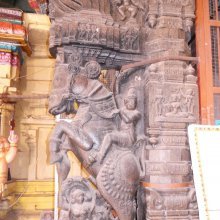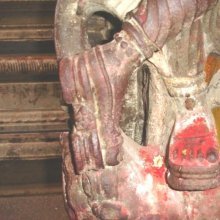Fanning: 1 definition
Introduction:
Fanning means something in Hinduism, Sanskrit. If you want to know the exact meaning, history, etymology or English translation of this term then check out the descriptions on this page. Add your comment or reference to a book if you want to contribute to this summary article.
Images (photo gallery)
In Hinduism
Natyashastra (theatrics and dramaturgy)
Source: Shodhganga: Elements of Art and Architecture in the Trtiyakhanda of the Visnudharmottarapurana (natya)Fanning (and dragging) is associated with Kapittha-hasta: one of the twenty-two Single-hand Gestures (in Indian Dramas) (known as asaṃyuktahastas), according to the Viṣṇudharmottarapurāṇa, an ancient Sanskrit text which (being encyclopedic in nature) deals with a variety of cultural topics such as arts, architecture, music, grammar and astronomy.—In the Śabdakalpadruma, the word kapittha is explained as a kind of tree where kapi i.e., monkey comes due to the greed of fruit. The word kapittha again denotes the fruit called wood apple. [...] This posture is used to denote sacrifice, holding of an umbrella or a garland or rope, dragging and fanning.

Natyashastra (नाट्यशास्त्र, nāṭyaśāstra) refers to both the ancient Indian tradition (shastra) of performing arts, (natya—theatrics, drama, dance, music), as well as the name of a Sanskrit work dealing with these subjects. It also teaches the rules for composing Dramatic plays (nataka), construction and performance of Theater, and Poetic works (kavya).
See also (Relevant definitions)
Query error!
Full-text (+103): Vijana, Avaculaka, Vyajana, Vidhupana, Jhadapani, Dhuti, Vyajanakriya, Vijenta, Upadhmanin, Jhadapanem, Udvijana, Vidhupenta, Phataphatanem, Vij, Vaincapakhada, Mantharu, Vidhalisu, Savyajana, Hamkahamki, Vijayamana.
Relevant text
Search found 98 books and stories containing Fanning; (plurals include: Fannings). You can also click to the full overview containing English textual excerpts. Below are direct links for the most relevant articles:
Brihad Bhagavatamrita (commentary) (by Śrī Śrīmad Bhaktivedānta Nārāyana Gosvāmī Mahārāja)
Verse 2.4.98 < [Chapter 4 - Vaikuṇṭha (the spiritual world)]
Verse 1.7.148 < [Chapter 7 - Pūrṇa (pinnacle of excellent devotees)]
Verse 1.4.65 < [Chapter 4 - Bhakta (the devotee)]
Garga Samhita (English) (by Danavir Goswami)
Verse 6.16.38 < [Chapter 16 - Seeing Śrī Rādhā’s Form]
Verse 4.22.13 < [Chapter 22 - Nanda and the Gopas See the Realm of Vaikuntha]
Verse 2.21.40 < [Chapter 21 - The Rāsa-dance Pastime]
Hari-bhakti-kalpa-latikā (by Sarasvati Thkura)
Text 10 < [Second Stabaka]
Sahitya-kaumudi by Baladeva Vidyabhushana (by Gaurapada Dāsa)
Text 8.15 < [Chapter 8 - Literary Qualities]
Yoga-sutras (Vedanta Commentaries)
Sūtras 24-30 < [Part IV - Liberation]
Chaitanya Bhagavata (by Bhumipati Dāsa)
Verse 2.20.16 < [Chapter 20 - The Glories of Murāri Gupta]
Introduction to chapter 20 < [Chapter 20 - The Glories of Murāri Gupta]
Verse 1.1.29 < [Chapter 1 - Summary of Lord Gaura’s Pastimes]

